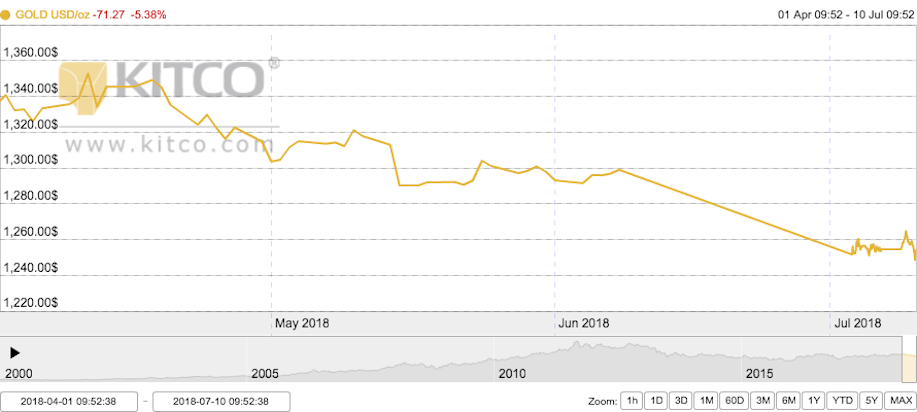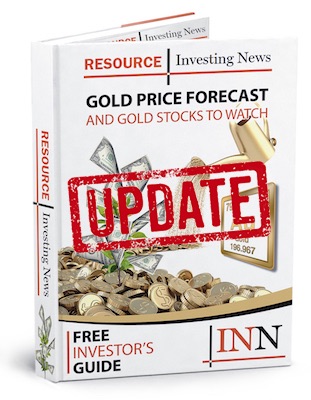The price of gold fell more than 6 percent in the second quarter, dipping below the crucial US$1,300-per-ounce mark in mid-May, where it would stay for the remainder of Q2.
A strong US dollar, benchmark US Treasury yields topping a seven-year high and a second Fed hike rattled gold over the quarter. While gains were made on the back of geopolitical concerns at the beginning of the period, investors shied away from holding bullion as a safe-haven during market uncertainty throughout the second half of the quarter, causing the precious metal to be in the position of lower highs and even lower lows.
Despite gold’s reaction to these factors, many industry insiders believe that this is simply a seasonally weak period for the yellow metal and that it will return to value within the next few months, with its safe-haven nature once again appealing and therefore allowing for prices to rise in the third quarter and beyond.
Read on for an overview of the factors that impacted the gold market in Q2, plus a look at what investors should watch out for in the next few months of the year.
Gold price update: Q2 overview
The price of gold sank 6.22 percent in the second quarter. As the chart below from Kitco shows, gold experienced mostly declines during the period, but reached its lowest point towards the end of June.

Chart via Kitco.
Gold hit its lowest point of all of 2018 on June 28, trading at US$1,247.10. The metal decreased on the back of concerns over the increasing tariff battle between the US and China. As previously noted, during this time, investors did not treat the yellow metal as a safe-haven, but rather backed away from it as they grew more concerned over the idea that if the tariff battle continued, growth would slow in both the countries, and the result could be a global recession.
When compared to gold’s lowest point of US$1,302.50 in Q1 2018, the metal’s dismal quarter becomes even more apparent.
Meanwhile, the precious metal found its highest point on the morning of April 11, reaching US$1,352.80. On that day, prices edged up when the US dollar sank in response to political tensions between Syria and the US. Unfortunately, gold could not maintain the increase following the release of minutes from the Federal Open Market Committee (FOMC) meeting that same day and it tumbled from its 11-week high before the markets closed.
Gold price update: Key drivers
As the third quarter of the year begins, investors interested in the gold market should be aware of a number of factors that could impact the precious metal’s price.
Most analysts agree that the greenback’s movements, geopolitical tensions and interest hikes will continue to be key drivers for the gold price for 2018.
With the US dollar making consistent gains throughout the second quarter, bullion became too expensive for investors to hold.
“A strong dollar makes gold more expensive to buy for holders of other currencies, which weighs on demand, while rising interest rates erode the metal’s attractiveness as an investment compared to yield-bearing assets,” Angela Bouzanis, senior economist at FocusEconomics, told the Investing News Network (INN).
Similarly, Mercenary Geologist Mickey Fulp addressed the strong US dollar stating, “[t]he strong inverse correlation coefficients show that over the past 10 months, when the dollar goes up, gold goes down, and vice versa. DXY (the US dollar index) has been on quite a roll since mid-April, rising from 89.4 to 94.8 for a gain of 6.0 percent.”
“During this time, gold dropped from US$1,346 to US$1,279 for a loss of 5 percent. These numbers further illustrate the ongoing negative dollar-gold relationship,” he added.
Byron King of Agora Financial sums up the relationship between gold and the US dollar in Q2 telling INN, “[t]here’s no sugar-coating to what happened in Q2; gold prices drifted down as the dollar strengthened.”
“The dollar strengthened due to the US Fed increasing interest rates, and Fed taking heads issuing guidance to expect more rate increases at regular intervals. Plus, global markets appear to perceive strong economic growth in the US, leading to a bid-up for dollars,” he added.
Geopolitical tensions also drove the yellow metal in Q2, allowing it to make small gains throughout the quarter.
“Tailwinds for gold come in the form of a seemingly inexhaustible series of political risk triggers,” Scotiabank (TSX:BNS, NYSE:BNS) said in its recent Commodities Outlook report.
Two of the largest geopolitical concerns of Q2 have been the ongoing trade war concerns between the US and China and US president Donald Trump’s tariff spree on several countries.
“The fall in gold prices was limited somewhat by a tumultuous global political environment. US President Donald Trump’s “America First” policies and the imposition of tariffs have caused deep diplomatic riffs among traditional G7 allies and kicked off a series of tit-for-tat tariff retaliations in recent weeks,” said analysts at FocusEconomics.
However, Q2 also saw gold moving away from its safe-haven status, which caused any gains to be short-lived, and, for the most part, insignificant.
“What we are seeing is a serious lack of large investor and institutional interest in the metals and mining sector. In my opinion, the major US and Canadian markets are topping, emerging markets are falling and all markets are being whipsawed by a petulant vindictive man-child with no real plan or interest in factual data,” Brent Cook of Exploration Insights told INN.
Finally, a second Federal Reserve interest hike once again impacted gold prices towards the end of Q2.
While gold made slight gains directly after the hike was announced, it would not last long. The following day, the US dollar rebounded and the precious metal lost its gains.
Adrian Day of Adrian Day Asset Management explained to INN why this interest hike had a negative …read more
From:: Investing News Network

